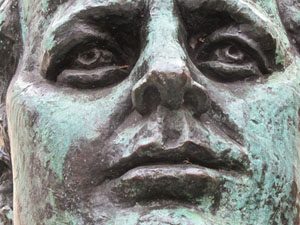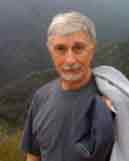by Robert Baker
In response to invitations, U.S. embassies need to send an official representative to many local cultural events with some American angle. As the most junior member of the London Embassy cultural staff, the least important representational events fell often to me. The JFK bronze head dedication was full of British local color. Part of that color was the still pervasive class system with clear cut upper class and lower class distinctions.

The London Arts Council had requested an Embassy official to attend and to make a few apposite remarks at the dedication of one of its benefactions. Like most official arts bodies by the 1960’s, the Arts Council had begun to award grants to minorities and to the poor, demonstrating that the arts were not only for the rich.
An ordinary British workman from the poor East End of London had received a grant to help him to cast in bronze, his heroic head of our assassinated President John F. Kennedy. I was picked to go to the event. I waited one chilly Monday mid-morning in 1972 on the Embassy front steps in Grosvenor Square for a London Arts Council car. It would take me to the fairly distant dedication site in the working class East End.
I was impressed when a huge, vintage, black Rolls Royce silently rolled up in the wintry breeze. Harold Sebag Montefiori, a large man in a long, lambs wool black winter coat with a black velvet collar stepped out after the chauffeur opened the rear door. I went down the steps to meet him, and climbed up into the car as he politely indicated. He was the Arts Council man for bronze heads and other grants. He told me about his work as we drove across London.
The huge car finally came to the East End. It slowed down as we drove into a lane, a suspiciously very clean lane, with little piles of coals in front of some doors. The streets leading to the lane had newspapers and scraps blowing in the wind. The coals in front of the tiny houses had been whitewashed, surely by the local Council to honor the Arts Council Rolls Royce. It was a Potemkin village scene come to London’s East End.
Near the end of the lane, we rolled grandly to a dignified stop before a small crowd, They stood in front of an alcove in a wall which held a gray stone plinth about six feet high, topped by a three-times life size, shiny bronze bust of President Kennedy‘s head. The sculptor was there in his light blue suit, with a white shirt and a dark blue tie. When I shook his hand, it was calloused, like my Dad’s. He was warm, frank and more than a little shy. He looked just about as my Dad would have looked if a great man from the Arts Council and someone from the American Embassy had come to honor his work.
The Rolls was almost the size of the little houses in the lane. It certainly was longer than they were wide. The Arts Council man towered over the artist, me and the little gaggle of neighbors and friends who had gathered for the dedication. Harold Sebag Montefiori gracefully praised President Kennedy and the Council’s work. He praised the sculptor for making the bronze head and for letting the Council sponsor it. I made a few remarks about Kennedy, the Council, American ties to Britain and our pleasure in the honor given to the President in the outstanding work of art before us. Polite applause followed each speech. The artist spoke of how he admired President Kennedy, mourned his untimely death and made the sculpture to honor him. He had made a very good likeness of the President. A brass plaque on the plinth gave the President’s name and dates. I was touched by the love in the artist’s voice, his work and the quiet admiration of his friends and neighbors.
After the artist spoke, we shook hands all around and said goodbye. The Council man and I piled into the Rolls and majestically moved off toward the main road through twisting narrow alleyways. Still in the narrow lanes, but about a block from the ceremony, a half dozen small boys appeared running alongside the Rolls. It was hard to hear their shouts through the thick glass and soundproofing, but they were clearly snarking us and the Rolls. I heard one yell, “F…Off !” among other things.
I turned with an innocent look to the Council man and asked, “What are the children shouting?” He smoothly replied,” God Save the Queen”. He took me to an exactly appropriate lunch suitable to my junior Embassy standing. It was a good lunch, but far from great. It was at a tarted up East End pub called “The Angel“, maybe named for the little angels running alongside us in the alleyway shouting “God Save the Queen!”![]()
American Diplomacy is the Publication of Origin for this work. Permission to republish is freely granted with credit and a link back to American Diplomacy

Bob Baker: 5 years intelligence analyst (USIA IRS); passed FSO exam; A-100 class; French language training; first post: Kampala, Uganda; next: Bamako, Mali; a year as a producer trainee, WETA; posted to London, Bonn, Berlin, Sydney, Los Angeles (Foreign Media Center), Vienna Regional Programs Office; retired in 1992; currently writing memoirs in LA.
